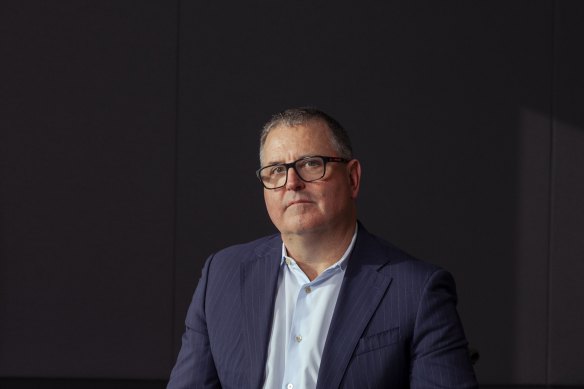Insurance premiums going up as IAG books bumper profit

Save articles for later
Add articles to your saved list and come back to them any time.
Insurance Australia Group boss Nick Hawkins says the company will lift premiums in the year to come, blaming rising inflation, reinsurance costs and the possibility of natural disasters, while signalling a profit of up to $1.4 billion for the next financial year.
The company behind insurance brands NRMA and CGU, among others, is the latest insurer to signal climate change as an industry risk that is pushing up premiums.
IAG chief executive Nick Hawkins said the bulk of the insurer’s gross written premiums would be through premium increases.Credit: Dominic Lorrimer
“The 2023 financial year was another significant ‘perils’ year, and we saw the devastating impacts of multiple large-scale events across Australia and New Zealand on our customers and communities,” Hawkins said, noting a 26 per cent rise in its natural disaster allowance to $1.1 billion for the 2024 financial year.
The results showed IAG’s home insurance premiums have risen about 20 per cent a year on average, while premiums for car insurance have gone up by about 15 per cent.
Despite posting net profit of $832 million, up 140 per cent, Hawkins said IAG’s underlying insurance margin shrank from 14.6 per cent in the previous year to 12.6 per cent in the 2023 financial year. “Elevated inflation in home and motor claims costs, as well as the higher natural perils allowance”, were driving factors, he said.
However, Hawkins said motor insurance costs had “definitely moderated” in the second half of the financial year. “We’re still expecting inflation in the 2024 financial year between 5 and 10 per cent, so it’s higher than average, but it’s moderated from where we were last year.”
Shares in IAG fell 0.6 per cent to $5.80 a share on Monday, despite the company declaring a dividend of 9¢ a share, up from 5¢ a year ago.
IAG’s gross written premium – a combined measure of premiums and volume of insurance policies – grew 10.6 per cent over the year, mainly driven by increased premiums.
While new customer growth has slowed down in the second half, Hawkins said retention remained strong at about 90 and 95 per cent for DIA’s motor and home insurance, respectively.
For the year ahead, Hawkins said he expected low double-digit growth in gross written premiums. “The bulk of that will be through pricing,” he said. That should deliver an insurance profit of $1.2 billion to $1.45 billion, up from $803 million, IAG said.
Australian Council of Trade Unions (ACTU) assistant secretary Joseph Mitchell criticised IAG’s profits, saying it was “beyond the pale to expect hardworking Australians to continue to cop increases to life’s essentials just to have big business creaming from the top”.
Hawkins said IAG was trying to balance the affordability of its products with the risks it was taking on. “We definitely recognise it’s a tough time for people and businesses,” he said. “Unfortunately, the expectation is increased frequency and severity of large events. We need to reflect that in pricing.”
The cost of perils and reinsurance has risen by about 50 per cent from 13¢ to the dollar in 2016 to about 20¢ to the dollar now, Hawkins said, which was incorporated into IAG’s pricing.
He also said IAG needed a strong balance sheet because it was an “economic shock absorber” for consumers, businesses and the country. “We provide a promise to our customers to protect them in times of need and pay claims, and we need to be financially strong to deliver on this promise.”
Hawkins said some of the insurer’s costs would probably come down over time, with both the Australian and New Zealand governments “pretty focused” on reducing inflation, but that reinsurance costs could continue to rise.
UBS analyst Scott Russell said IAG’s earnings, dividend and insurance profit were below market expectations, but the insurer’s underlying margin looked good, with solid gross written premium growth guidance.
Citi analyst Nigel Pittaway said IAG’s result was “a little disappointing in a few areas” and the company’s share price performance would depend on investors’ willingness to look beyond the result to the potential growth ahead.
The Market Recap newsletter is a wrap of the day’s trading. Get it each weekday afternoon.
Most Viewed in Business
From our partners
Source: Read Full Article

